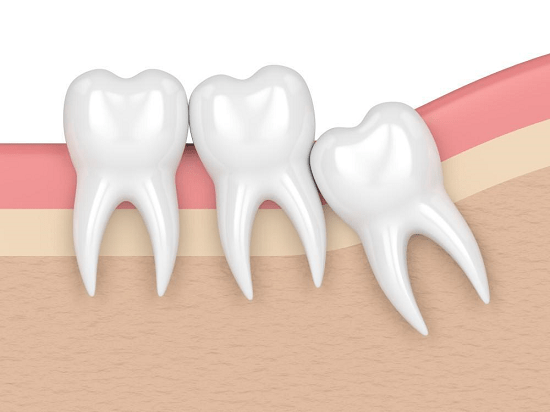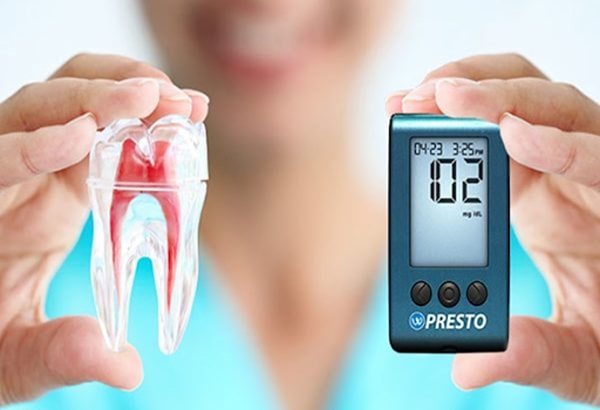Contents
- 1 Why should wisdom teeth be extracted early?
- 2 Can all wisdom teeth be extracted at the same time?
- 3 When is it appropriate to remove wisdom teeth?
- 4 Methods of Wisdom Tooth Extraction
- 5 Notes when removing 4 wisdom teeth at the same time
Why should wisdom teeth be extracted early?
Wisdom teeth appear in adulthood. This is the last teeth of the jaw, located in the back of the mouth. These teeth can also be called the third molar. However, they do not contribute much to the chewing function of the jaw, instead, they can cause a lot of trouble for people. In some cases, wisdom teeth need to be removed immediately because:
Wisdom teeth cause pain
If misaligned wisdom teeth are not promptly intervened, they will not stop growing in size. When wisdom teeth begin to erupt, there is a risk of causing gum disease.
In case the teeth lack the area to fully grow, it will be impacted, which means it will not fully erupt but grow under the gum instead. This increases the risk of complications and prolonged pain makes it difficult to eat and drink and causes inconvenience in daily life.
Affects adjacent teeth
Wisdom teeth with pulp inflammation or decay will affect the second molar. Cavities spread quickly and can cause tooth loss if being left for a long time.
In addition, the misaligned wisdom teeth will crash into the adjacent teeth if there is not enough room to erupt. As a result, the nearby teeth will become loose or will be damaged. In case the wisdom tooth is decayed, the teeth next to it will be decayed too.
Therefore, when detecting misaligned wisdom teeth, it is necessary to take action immediately.
The risk of causing inflammation around the crown
Inflammation around the crown is a common symptom when wisdom teeth are misaligned. Chronic or acute gingivitis usually occurs when the periodontal period around the wisdom tooth is heavily impacted.
The consequences of this condition are extensive cellulitis proliferation, redness, pain, and swelling.
Bad breath
The location of the wisdom teeth is in the innermost part of the jaw, so when eating and drinking, it is easy to accumulate plaque and bacteria. The process of cleaning wisdom teeth is also difficult. Therefore, if you do not clean your teeth carefully, food particles can easily adhere to the surface of the teeth, creating an ideal environment for bacteria to form and develop, thus causing bad breath.
Bite joint trauma
One of the most serious consequences of misaligned wisdom teeth is the misalignment between the upper and lower jaws. When this situation is encountered, the customer needs to perform orthodontic treatment. For severe conditions, surgical intervention is required in order to move the teeth to a suitable position.
Can all wisdom teeth be extracted at the same time?
According to experts, it is possible to remove all 4 wisdom teeth at once. However, customers need to go to a hospital or a reputable dental address for a dentist to check and give specific advice according to the situation of each person. The dentist will appoint the number of wisdom teeth to be extracted. In case of needing to extract many wisdom teeth, it is necessary to check the degree of deviation.
The analysis process is based on X-ray film, from which to evaluate the position, size, and inclination of the wisdom teeth. Thereby, the dentist will decide to extract the number of wisdom teeth to be removed. After the tooth extraction process, you should maintain a scientific diet, and take care of the wound carefully to recover quickly.

When is it appropriate to remove wisdom teeth?
To know if you should remove wisdom teeth or not, you need to rely on the following factors:
Cases where you need a wisdom tooth extraction
Decayed wisdom teeth
Bacteria multiply rapidly over a long period of time leading to gingivitis, periodontitis, etc. Prolonged condition without timely intervention increases the risk of pulpitis and inflammation.
Gingivitis caused by wisdom teeth
The misaligned teeth lead to some trauma that negatively affects the soft tissue around the gums, as a result, the innermost gum margin will be swollen.
Adverse effects on adjacent teeth and bones
Adjacent teeth are at risk of wobbling and being impacted if wisdom teeth are misaligned. Crooked or impacted wisdom teeth even cause jaw bone loss.
What age is suitable for wisdom tooth extraction?
The most appropriate age to remove wisdom teeth is between 18 and 25 years old. At this time, the new tooth root has only formed about 60%, so it is easy for surgical intervention.
Over the age of 35, the surgical procedure for tooth extraction becomes more difficult because the bones are denser and harder. The post-operative wound healing process also takes a longer time and requires meticulous care to achieve good results.
The right time for wisdom tooth extraction
Some of the following times are considered ideal for wisdom tooth extraction:
- Wisdom teeth affect adjacent teeth or cause pain and negative effects.
- Wisdom teeth grow crooked and collide into adjacent teeth, causing misalignment.
- Wisdom teeth are too big or too small, which leads to difficulties in cleaning, caring, and eating.
- Teeth that develop normally but do not have opposing molars. As the wisdom teeth grow longer, the opposite jaw gums will be affected.
Cases where wisdom teeth should not be extracted
The extraction of wisdom teeth should not be applied in some of the following cases:
- Wisdom teeth grow normally and have no complications.
- People with chronic diseases such as cardiovascular disease, blood clotting disorders, diabetes, high blood pressure, etc.
- People who are newly ill, when their immune system is still weak and unstable.
- Women who are pregnant or breastfeeding are contraindicated to extract many wisdom teeth at the same time.
- Customers with oral inflammatory diseases need to be treated thoroughly before the procedure.
Methods of Wisdom Tooth Extraction
There are 2 solutions to extract wisdom teeth for customers to choose from:
Traditional tooth extraction method
Extract wisdom teeth using specialized pliers through strong force to break the roots, then pull the teeth out of the socket. Because the tooth extraction tool is pliers, the time is relatively fast. The downside is that it needs to be carried out under the hands of an experienced doctor because it is prone to infections and dangerous complications.
Using an elevator to extract teeth with the aim of expanding the socket, breaking the ligament system. Loose roots make the extraction process more convenient. The doctor can use the whole elevator or use a combination of elevators and pliers to pull the tooth out.
The procedure of tooth extraction with elevators is quite safe when performed by a good doctor. However, after the procedure, it is easy to cause invasion and trauma to the tooth socket. Soft tissues are at risk of injury and infection.
Piezotome ultrasonic technology for wisdom tooth extraction
Wisdom tooth extraction using ultrasound Piezotome is the most modern technology. The machine works based on the impact mechanism of piezo-ultrasonic waves, making the process gentle and safe.
This method only affects the wisdom teeth and is completely non-invasive to the jawbone or soft tissue. This helps the gums around the teeth to avoid negative effects, limiting numbness in the lips and cheeks.
The procedure takes place quickly, minimizing the feeling of pain. The wound does not have unexpected complications so this method is suitable for both simple to complex cases.
The only minus point of this method is the cost of extracting teeth using the Piezotome machine will be slightly higher than other traditional tooth extraction techniques.
Notes when removing 4 wisdom teeth at the same time
To ensure the expected wound healing process and avoid complications, customers should note the following points:
Take pain relievers, anti-inflammatory drugs
Use anti-inflammatory and pain relievers exactly as prescribed by the dentist. Do not arbitrarily buy drugs from outside without consulting a doctor.
Bite medical cotton gauze to stop bleeding
During the first few hours after the extraction of the tooth, the wound will bleed a lot. Customers need to use medical cotton gauze to stop bleeding. In case the bleeding does not stop, it is necessary to visit the dentist for intervention.
Cold compress for pain and swelling
When there is pain after wisdom tooth extraction, customers can use a cold compress. Wrap ice in a bag and then hold it on the outside of the cheek around the location of the newly extracted tooth. Perform continuously for 10 minutes, 3 to 4 times a day.
Thorough dental hygiene
After the extraction is completed, it is necessary to pay close attention to the care to avoid infection. Customers should use physiological saline, and mouthwash daily to clean the oral cavity.
Proper diet
In the first days of tooth extraction, customers should eat soft, easy-to-swallow foods such as porridge, and soup. Drink milk, and fruit juice to increase the body’s immune system. Absolutely do not consume hard, chewy foods that require a lot of chewing force.
In conclusion, removing 4 wisdom teeth at a time is completely feasible, but it is necessary to visit a dentist for specific advice. This is the only way to ensure safety and avoid the risk to oral health.















